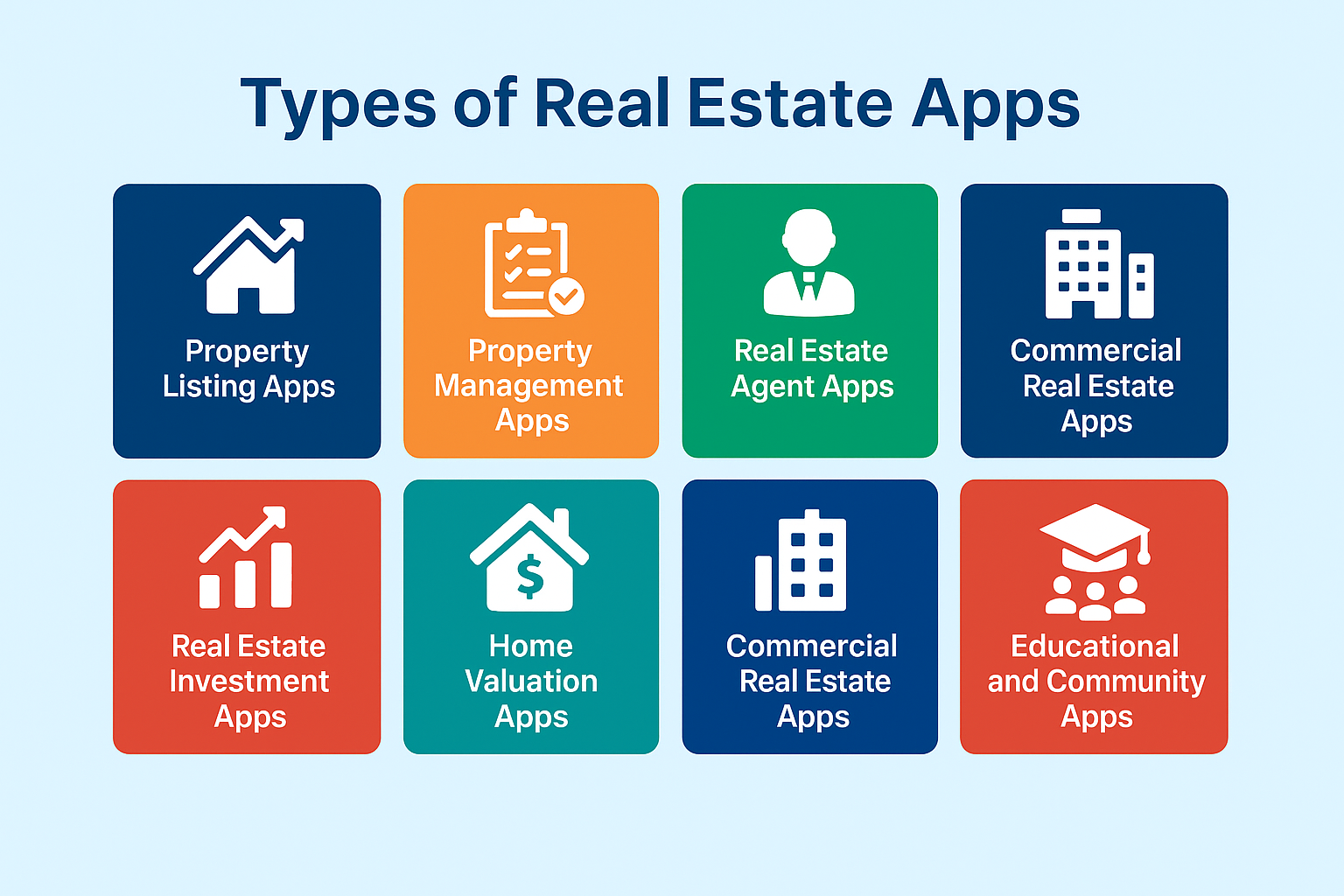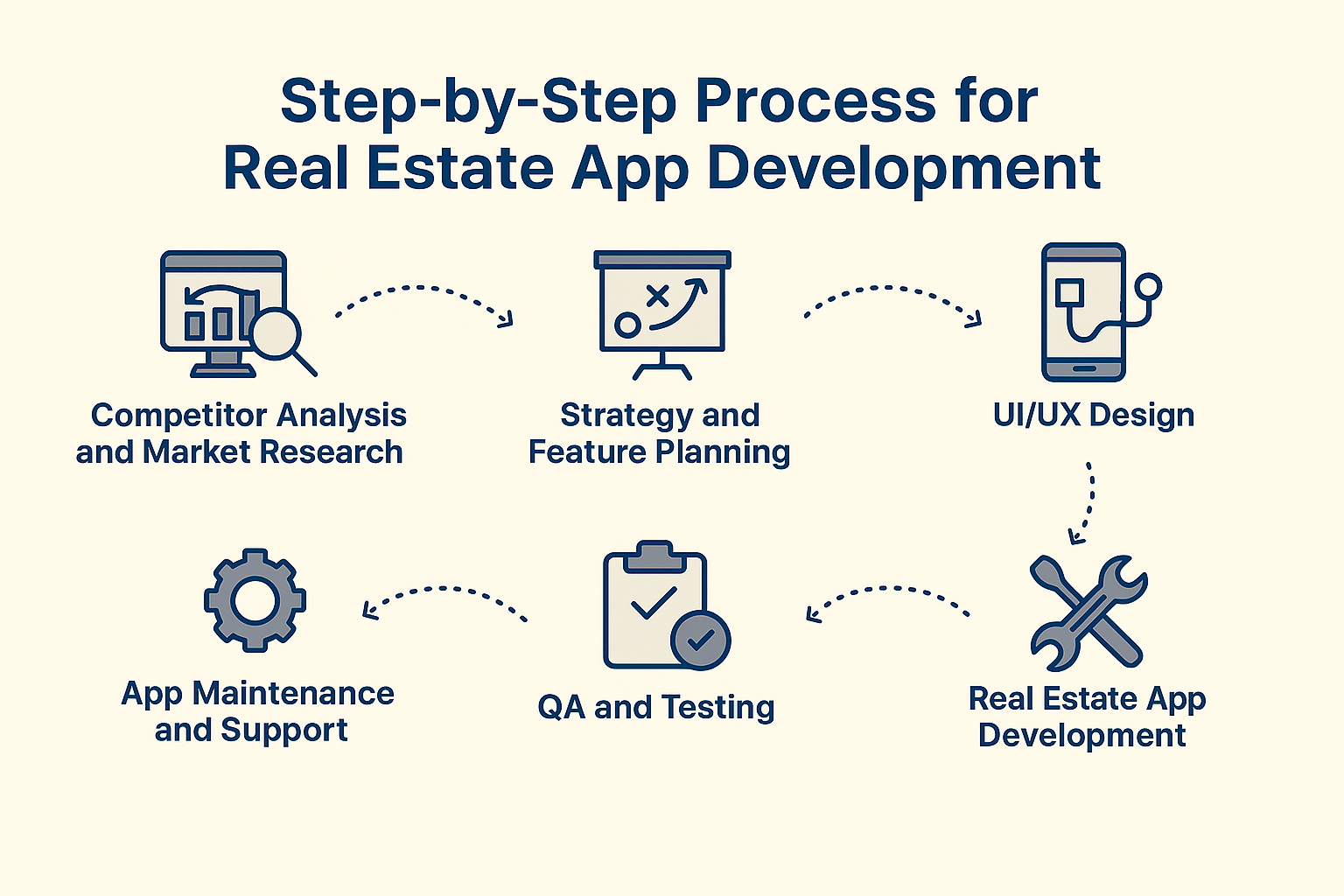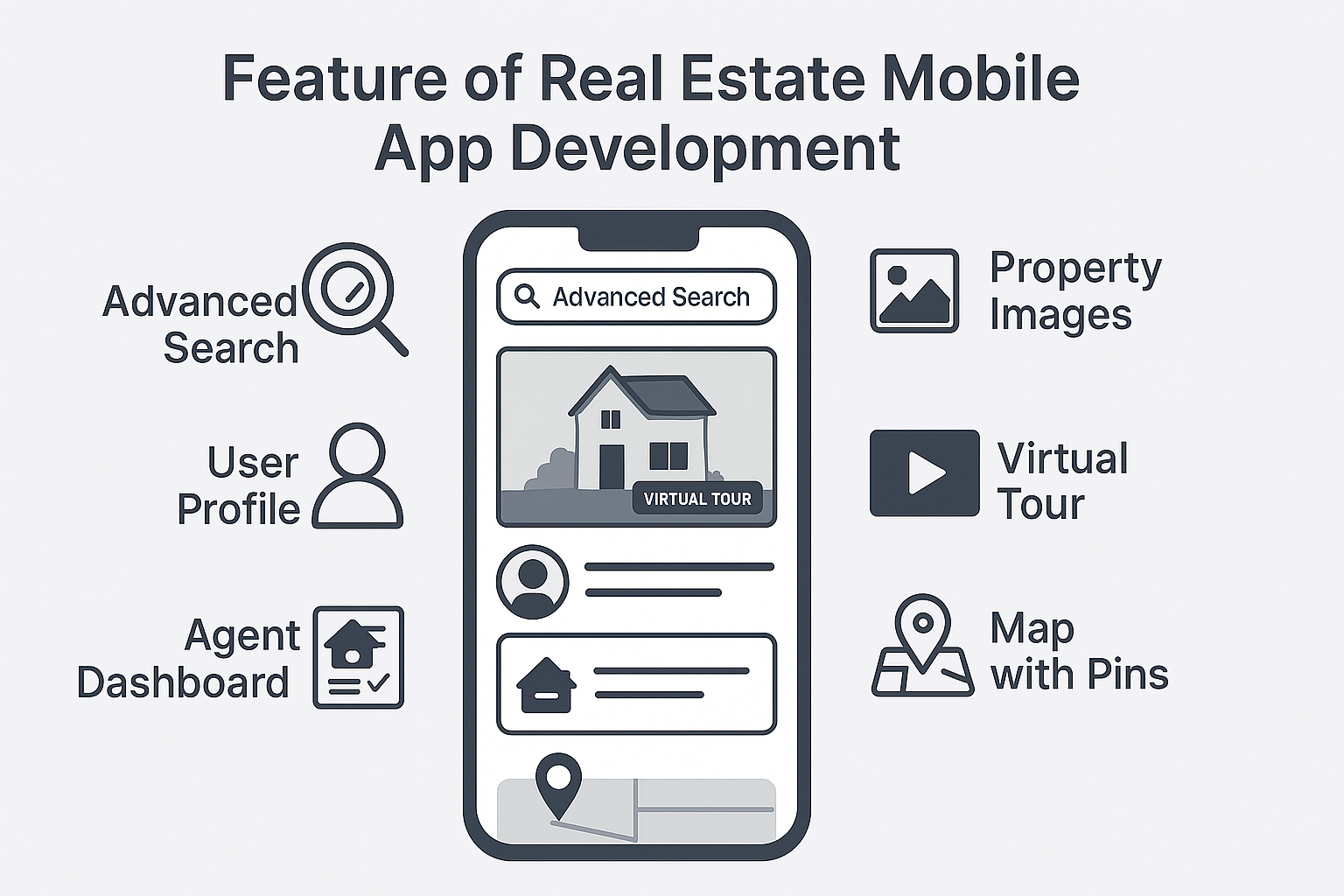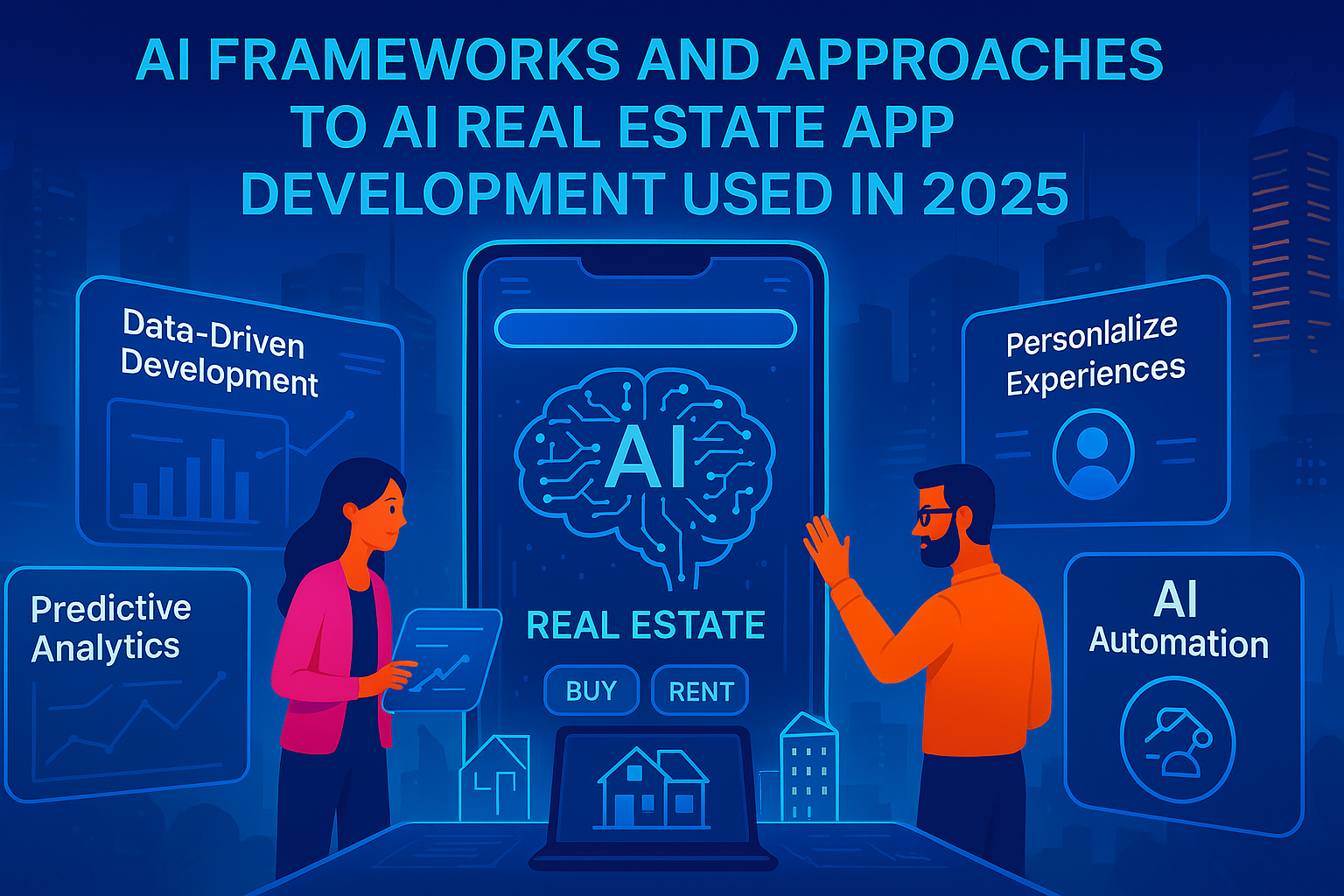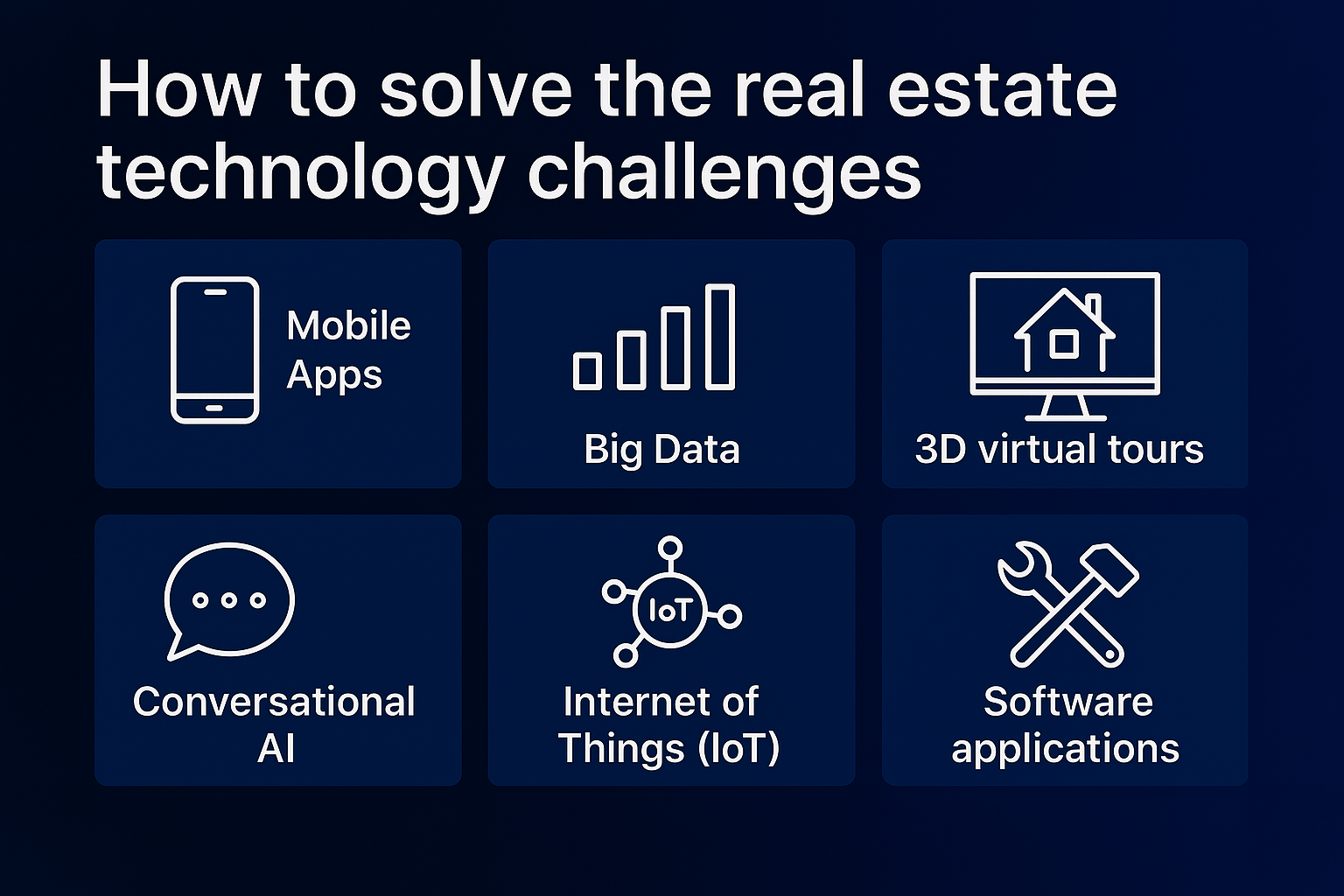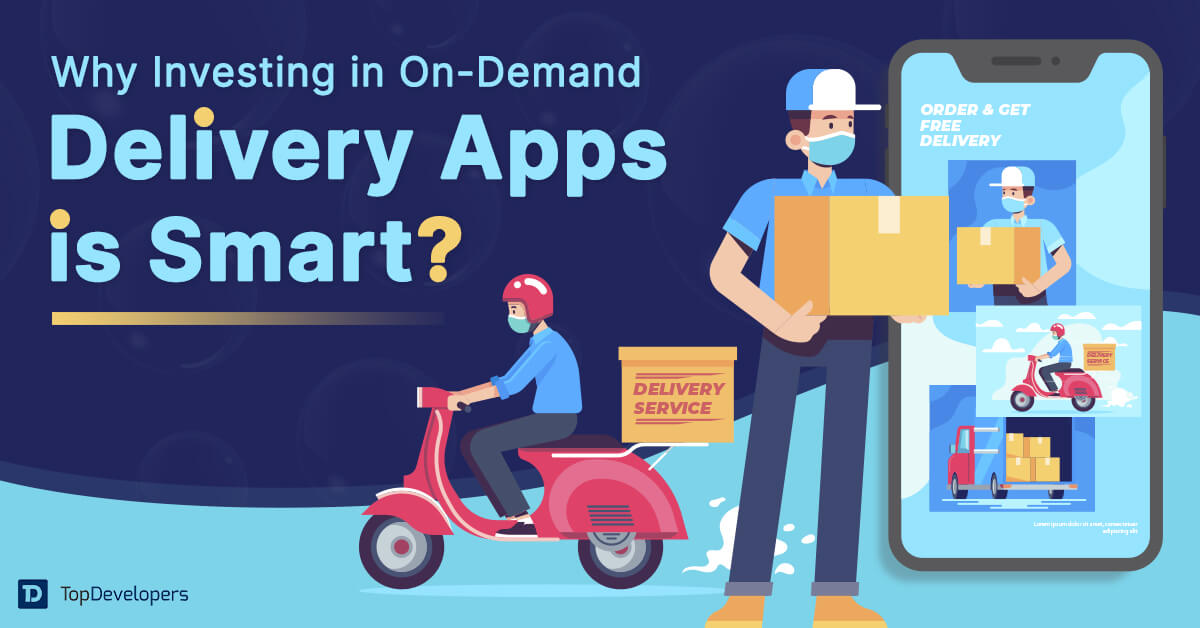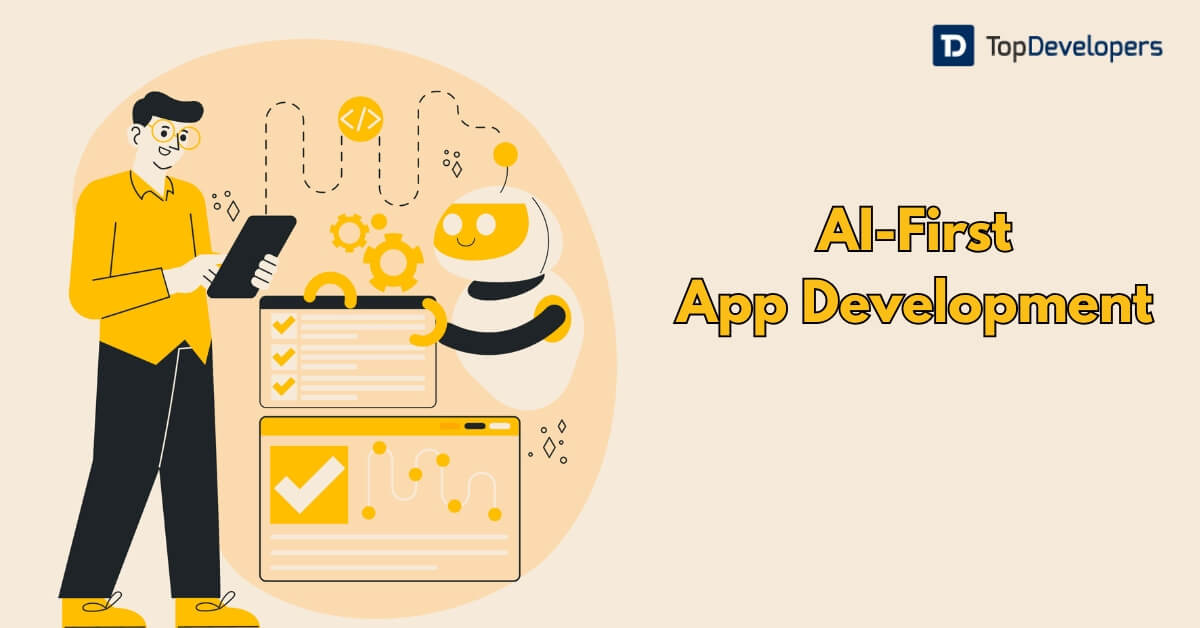
The scene of real estate is changing profoundly digitally. The days of depending solely on a basic listing website are long gone. Homebuyers, sellers, and brokers of 2025 want simple, smart, immersive digital experiences. Developing a successful real estate app today necessitates a forward-thinking approach, rather than focusing solely on the present. With more than 17,000+ documented transactions in the first two months, the UAE’s residential real estate market showed a mind-boggling rise of 43.9% in 2023. Now generating 5.5% of the UAE’s GDP, real estate has become a major economic engine for the country as it turned away from oil-related businesses.
Investors are flocking to take advantage of the significant business opportunities created by digital transformation during this market development. Property Finder’s enormous popularity—16 million monthly visits and a 65% market share—drives real estate firm owners to question how they may create such an app. This tutorial will guide you through the essential issues, features, technologies, and procedures required to develop a distinctive real estate app for the competitive market in 2025.
1. Market Growth and Opportunity
- The market for global real estate software and apps was around $3.8 billion in 2024, and it is estimated to climb to $4.6 billion by 2031.
- By 2029, the wider real estate software market is projected to reach $19.58 billion, with a growth rate of 11.2% per year since 2025.
- AI in the real estate area is expanding quickly, as the sector is expected to reach $1.8 trillion by 2030 with a 35% average growth rate.
2. App Development Costs
- Developing an app for real estate could cost from $20,000 to $300,000 or more based on its complexity, features, and the use of AI.
- Using AI and advanced technologies in development can raise the budget needed for the project
Table of Contents
- What is a Real Estate Mobile App?
- Types of real estate apps
- Step-by-Step Process for Real Estate App Development
- Features of Real Estate Mobile App Development
- AI Trends in Real Estate Application Development
- Key AI Trends in Real Estate Application Development
- AI Frameworks and Approaches to AI Real Estate App Development Used in 2025
- Frameworks Enhanced by AI in Real Estate App Development
- Generative AI in Real Estate App Development
- Benefits of Real Estate Mobile App Development for Buyers, Sellers, and Real Estate Agents
- Cost of Developing a Real Estate App Like Property Finder
- Cost-Optimization Strategies in Real Estate App Development
- Tech challenges in the real estate industry
- How to solve the real estate technology challenges
- Strategies for Real Estate App Development Monetization
- Conclusion
What is a Real Estate Mobile App?
Consumers are looking to real estate mobile apps more and more as cellphones and tablets become more common to search for homes, interact with agents, and expedite their purchase or selling process. Real estate application development has surged as companies try to satisfy the changing wants of their customers by means of this change in consumer behavior.
A real estate mobile app is software meant especially for tablets and smartphones to support several facets of the real estate sector on mobile devices. For customers as well as various real estate service providers, these mobile applications have many uses.Real estate software development companies specialize in building these feature-rich mobile apps, ensuring they are tailored to market needs and equipped with the latest technological advancements. These companies focus on delivering seamless user experiences, robust security, and scalable solutions to help real estate businesses stay competitive in a rapidly evolving digital landscape
You will frequently encounter the following types of real estate apps:
- Property valuation app
- For-sale and rental listing app
- Property management app
- Real estate investment app
- Online property booking app
Types of real estate apps
Property Listing Apps
- Purpose: Enable consumers to search, filter, and peruse homes for rent or sale.
- Features: Advanced search options (price, location, home type, amenities), high-quality photos, 3D virtual tours, interactive maps, and real-time market data abound.
- Examples: Among the examples are Zillow, Redfin, RealtoTrulia, Trulia, and Magicbricks.
- Use Case: Perfect for renters searching for homes with comprehensive knowledge, including area statistics, school proximity, and pricing trends, as well as homebuyers.
Property Management Apps
- Purpose: Help renters with payments, maintenance, and operations under the direction of landlords and property managers.
- Features: Tenant communication, rent collecting, maintenance request tracking, document storage, and e-signatures comprise features.
- Examples: For configurable workspace management, apps like Notion and Dotloop—for transaction management—have samples.
- Use Case: Simplifies administrative chores for many property managers, therefore lowering manual labor.
Real Estate Agent Apps
- Purpose: Help agents in handling client management, listings, calendars, and marketing initiatives.
- Features: Features include CRM tools, lead tracking, automatic scheduling, video marketing—BombBomb—and data on listing performance.
- Examples: BombBomb, Pivo (for AI-driven virtual tour videos), and Forewarn (for client background checks).
- Use Case: Assures agents of client connection, organization, and increased output.
Real Estate Investment Apps
- Purpose: Often via REITs or crowdsourcing, the goal is to encourage property or real estate fund investments.
- Features: Features include property comparison tools, rental revenue predictions, ROI calculators, and access to business or residential investments.
- Examples: Among examples are Fundrise (for non-accredited investors), CrowdStreet, RealtyMogul, and Arrived Homes (for fractional ownership).
- Use Case: Provides minimal entrance barriers to let both accredited and non-accredited investors diversify portfolios.
Home Valuation Apps
- Purpose: Estimate home prices based on location, size, renovations, and market trends using AI-powered models.
- Features: Real-time price data, neighborhood analytics, and mortgage calculators are among its features.
- Examples: Among examples, Homelight powers Zillow’s Zestimate and U.S. News Home Value Estimator.
- Use Case:Assures buyers of affordability and helps sellers decide reasonable rates.
Commercial Real Estate Apps
- Purpose: Emphasize commercial buildings for lease or sale, including offices, stores, or industrial sites.
- Features: Features include rental rate research, market situation observations, and investor and buyer networking tools.
- Examples: For instance, LoopNet has over 500,000 commercial property listings.
- Use Case: This service assists companies and investors in finding non-residential real estate.
Rental Apps
- Purpose: Help consumers locate either long-term or temporary rental properties.
- Features: Features include user evaluations, payment processing, owner communication, and booking automation.
- Examples: Airbnb, Trulia (with rental-specific divisions).
- Use Case: Makes renting for renters’ search and booking easier.
Renovation and Design Apps
- Purpose: Aid in home improvement, interior design, or renovation planning.
- Features: Visualization tools, contractor connections, and design inspiration galleries.
- Examples: Houzz (for visualizing furnishings or finding contractors).
- Use Case: Helps buyers and sellers enhance property appeal or plan renovations.
Educational and Community Apps
- Purpose: Provide resources, networking, or learning for real estate professionals and enthusiasts.
- Features: Forums, market analysis, and educational content on real estate operations.
- Examples: BiggerPockets (for industry insights and networking).
- Use Case: Supports professionals and investors with knowledge and community engagement
Step-by-Step Process for Real Estate App Development
If you are considering creating a real estate app, you have most likely seen how these programs are changing property purchase, selling, and renting practices. From virtual tours to flawless property searches, real estate applications are becoming a regular tool for everyone negotiating the housing market. Still, how would you design an app that distinguishes itself? This detailed guidance will enable you to realize your concept and have influence in this cutthroat field.
Step 1: Competitor Analysis and Market Research
Without a blueprint, you wouldn’t begin to construct a house? Your app follows the same rule. Spend some time grasping the market and your rivals before you do anything. This is the discovery phase, and producing anything original depends on it.
- Explore Your Competitors: Review other real estate applications closely. They present what? For them, what is going to work? More significantly, what is absent? These holes provide your app chances to shine.
- Know Your Audience: For what reason are you developing this app? First-time house buyers, Tenant? Employees? Knowing your target helps you create features meant to really address their issues.
- Follow Market Trends: What is trendy in real estate technology? Among the developments influencing the sector are virtual tours, suggestions driven by artificial intelligence, and sophisticated property search filters.
Starting with solid research guarantees that you are creating the app customers really need, not simply another one.
Step 2: Strategy and Feature Planning
Having done your research, it’s time to create a strategy. Consider this the “blueprint” for your app.
- Set Milestones: Create stages—design, development, testing, and launch—for the project. This road plan facilitates tracking of development and keeps everyone in agreement.
- Start with the MVP Development: Designed as a stripped-down, basic version of your program, an MVP (Minimum Viable Product) consists only of the basics. This might involve initially concentrating on property listings, search criteria, and a contact form. You may add sophisticated capabilities after the idea has been confirmed.
- Plan monetization: Will adverts help your software turn a profit? Subscriptions? A commission on real estate sales? Early on, figure this out so you can use a monetization strategy to bake it into the framework of your product.
- Integrate with Real Estate Systems: Would you want to provide consumers instant property updates? Either develop alliances with landlords and brokers or link your app with MLS (Multiple Listing Service) systems.
Your secret to creating effective software free of pointless delays or excessive expenses is a clear strategy.
Step 3: UI/UX Design
Let’s be clear about user-centric design: nobody will remain around if your program feels cumbersome or looks poor.UI/UX design comes in here.
- Keep It Simple: Your app needs to be easily navigable. Users should be free to search for homes, examine information, and contact sellers without any doubt.
- Make It Visually Attractive: Real estate is really about pictures. A great difference is made by excellent property photos, elegant design features, and a tidy layout.
- Think cross-platform: The app must appear and function seamlessly everywhere, whether your customers are on iOS, Android, or a tablet.
- Add Interactive Features: Virtual tours, property comparison tools, and interactive maps are excellent methods to keep consumers interested and enthusiastic.
Good design is about creating an experience that will entice consumers back, not just about appearance.
Step 4: Real Estate App Development
The magic takes place here. Development is about converting all of your design and planning efforts into an essentially working app.
- Front-End Development: Your users see and engage with front-end development; hence, it must be responsive, quick, and seamless.
- Back-end Development: Managing data, interacting with MLS, and handling secure transactions—the behind-the-scenes labor driving your app.
- Integrate Payment Gateways: Make sure customers may pay safely and quickly using real estate management systems should your app incorporate subscriptions or transactions.
- Stick to the Roadmap: Review your roadmap to ensure the app is being created in line with your objectives and on time.
Working with seasoned developers can help you avoid several difficulties at this stage.
Step 5: QA and Testing
Testing is very crucial, as no software is flawless on the first attempt.
- Catch Bugs Early: Run tests to identify and repair problems before users ever encounter them.
- Test Performance: Does the program load fast? Can it manage simultaneous numbers of users?
- Focus on Security: Emphasize security, as sensitive data like payment details needs to be very secure.
Though it’s not the most glamorous stage, deploying professional, dependable software depends on testing.
Step 6: App Deployment
It’s time to let the world know about your app, last but not least!
- Launch on App Stores:Post your app on Google Play and the App Store. Use their advice to stay clear of delays.
- Optimize for Visibility: Make consumers locate your app using App Store Optimization (ASO) techniques. This covers picking appropriate keywords, crafting a compelling description, and using striking images.
- Promote the App: Market your app using social media, advertisements, and email campaigns instead of just launching and hoping for the best.
Early success is built up by a good launch plan.
Step 7: App Maintenance and Support
The effort never stops after your app is online.
- Provide Support: Be ready to answer user queries, debug problems, and, where necessary, release rapid repairs.
- Listen to Feedback: Pay attention to evaluations and statistics to know what’s working and what’s not.
- Keep It Fresh: To keep users interested, routinely provide fresh features, bug repairs, and design enhancements to your program
Please view this as ongoing App Maintenance and Support for your mobile app, ensuring it stays helpful and relevant over time.
Features of Real Estate Mobile App Development
In 2025, Real Estate Mobile App Development will include sophisticated property search with AI-powered suggestions, interactive listings with high-resolution photographs and virtual or AR/VR tours, and user profiles for buyers, sellers, and agents. Smart analytics and AI-powered chatbots provide you immediate help and make property recommendations and loan calculators more relevant to you. The app is both innovative and user-friendly since it has secure payment gateways, document management with e-signatures, in-app chat, push notifications, and real-time map integration. These features make it easier to use, safer, and more enjoyable.
1. Advanced Property Search & Filters
A strong search engine is necessary so that consumers can locate homes based on various factors, such as location, price, kind of property, size, number of bedrooms, and amenities. Modern applications employ AI-powered search to suggest properties that fit the user’s needs, making the process of finding them quicker and more relevant.
2. High-Resolution Images & Virtual Tours
In real estate, pictures are very important. Users may look at homes from afar thanks to high-quality photos, 3D property views, and virtual or augmented reality tours. This not only saves time, but it also helps buyers and renters make smart choices without having to go see the property in person.
3. User Registration and Profiles
Buyers, sellers, and brokers may create personalized profiles that let them store their preferences, keep track of their search history, and get suggestions that are just right for them. Profiles are like professional storefronts for agents and sellers. They show off their skills, prior deals, and customer feedback.
4. Property Listings Management for Agents
Agents and property owners require tools that make it easy to add, change, and update property information. Listing management solutions that work well, such as those that let you post a lot of listings at once and make media galleries, help keep listings correct and up to date. Analytics and automatic alerts let you keep track of how well your property is doing.
5. Interactive Maps and Geolocation
Maps that let you interact with them and geolocation Integrated maps show where properties are and what adjacent facilities they have, such as schools, parks, and public transportation. Users may utilize heat maps and neighborhood information to decide whether a home is right for them depending on their lifestyle demands.
AI Trends in Real Estate Application Development
AI trends in real estate app development for 2025 are changing the industry with advanced predictive analytics that make it easier to find high-yield investment opportunities and make better decisions. AI algorithms analyze user behavior and preferences to give hyper-personalized property recommendations and cut down on search fatigue. AI-powered chatbots and virtual assistants can help you right away, schedule visits, and make lead management easier.
Virtual tours and interactive maps make it easier to explore properties from a distance, while automation makes document processing and property management activities more effective. These new technologies are making real estate operations more efficient, user-friendly, and data-driven.AI is changing the way real estate agents work by making things faster, more intelligent, and more focused on the needs of clients.
AI Development Companies in Real Estate sector offer agents systems for attracting customers, understanding trends, and making relevant property suggestions. With chatbots, instant queries from clients are resolved, viewings can be scheduled in advance, and follow-ups are taken care of, freeing agents to work on more demanding negotiations.
AI-powered systems look at property data to come up with ways to set prices that will be competitive. Image recognition software improves listings by adding virtual staging and finding flaws. AI-driven personalized marketing sends customers property suggestions that are just right for them. Agents have a leg up in a fast-paced market by using AI to make their work easier, more efficient, and quicker to complete sales. Real estate will be smarter, quicker, and driven by AI in the future. AI is changing the job of real estate agents in a big way.
Key AI Trends in Real Estate Application Development
Some important AI trends in real estate app development for 2025 are artificial intelligence selecting homes for users, upcoming trends in the market and appraisal done automatically. Virtual and augmented reality helps simulate tours using AI and chatbots make helping customers and managing leads more efficient. Agents and clients are now benefiting from automated processes, easier searches and AI in different aspects of their work.
Personalized Property Recommendations
It’s impossible to emphasize how powerful AI is in making real estate apps. AI can help you create a product or service that meets each customer’s needs.
AI-powered technologies collect and evaluate huge quantities of data. For example, machine learning algorithms look at how users behave, what they search for, and what they do on the site or app to make sure the user experience is perfect and exactly what the customer wants.
In the real estate market, people are already using smart search and AI suggestions. Zillow and other sites use collaborative filtering to match buyers with houses that fit their needs. This lowers the cost of buying a home and speeds up the search process.
GenAI-powered Virtual Tours
Generative AI (or GenAI for short) is a kind of AI that is only interested in making new things, including texts, pictures, videos, or sounds. Generative adversarial networks are one of the most important frameworks in generative AI that is primarily focused on real-life imagery.
GANs employ two neural networks that operate against one other: a generator that makes data and a discriminator that checks the data’s authenticity. They create things like pictures or music that seem real. The model training procedure is hard, takes a lot of time, and is a lot of work, but the results are amazing: AI-generated photographs look nearly exactly like real-life shots.
This is a great way to employ AI in the creation of real estate apps. Real estate applications will be able to make lifelike 3D property representations and virtual tools that let you stage a home and change the decor dynamically.
Real estate applications that employ this technology let customers see how furnishings will look or how the color of the walls will change in real time. The use of machine vision makes it even easier for agents to update their listings by automatically converting images into descriptions.
Predictive Fraud Detection Systems
AI may also be used to make security better and more dependable in fields like real estate where the stakes are high. This is very useful for AI in real estate app development since it helps make sure that the app is safe and that the user experience is easy and seamless.
AI-first security solutions utilize behavioral analytics to detect strange transaction patterns and stop fraudsters from getting to the data. AI security solutions automatically start multi-factor authentication when, for example, there are dramatic changes in how payments are processed or when someone signs in from an unexpected place.
This added layer of protection makes it far less likely that someone would apply for a loan fraudulently. It also makes the experience safer and more secure for consumers, but it only requires more work when suspicious behavior is found.
Automated Valuation Models
Another application of AI in real estate app development is predictive analytics, which may be very helpful for both users and landlords. ML algorithms look at a lot of data, such as property specifics, market trends, and information about the area, to provide property appraisals in real time.
AI-powered automated valuation models are quite accurate since they are trained on the most recent real-world data that is relevant. These techniques usually come within 3.5% of the real selling prices of properties, which is a lot more accurate than older approaches.
These systems can automatically find essential property characteristics from listing images, which makes valuations even more accurate. This is because they leverage computer vision technology instead of only relying on the property attributes in the CRM or added by the user.
This speeds up and makes property evaluations more accurate for buyers, sellers, and real estate agents.
Chatbot-driven Customer Service
Chatbots and AI chatbots have made it more easier for real estate app users to talk to one other right away. The user doesn’t have to copy and paste contact information and write the request in an email or message; AI responds right away.
Over 80% of the first queries from people who want to purchase or rent are now being answered by conversational AI systems. AI in real estate app development employs natural language processing algorithms to figure out what the question is and sentiment analysis to figure out how urgent and what kind of inquiry it is.
AI in real estate apps can also comprehend and respond to questions in several languages, which not only expands the market but also makes sure that all consumers get the same high-quality service.
Also, if you use AI in the real estate app development process to connect a CRM or property database, chatbots may swiftly get and send information about property listings. This cuts response times by 90%, giving users quick and correct information and making them happier and more involved.
Predictive Maintenance Analytics
AI is applied in several areas of real estate app development, and property management is one of them.
IoT sensors and machine learning algorithms work together to make real estate property management applications even more useful by forecasting when rental properties will require repairs.AI-powered applications may find problems before they become big ones by looking at past data, data from IoT sensors, and how well equipment works.
This method cuts down on emergency repairs by 45%, which makes it easier for property managers to plan regular maintenance.
Because of this, property management works better, tenant problems are fewer, and the property is better cared for overall, making it a nicer place to live.
Tenant Experience and Community Engagement
Using AI in the process of making real estate apps not only makes the apps more accurate and new, but it also helps tenants become involved and establish community.
AI can make a big difference in how people living in multi-family real estate and residential complexes interact with one other. Property managers may effortlessly talk to tenants with conversational AI built into real estate mobile applications. This lets them swiftly meet their demands or let them know about any news.
AI powered real estate applications may also help keep tenants interested by planning events and activities that fit their interests and looking at social data.This helps make communities stronger and more linked, which makes people happier and keeps them together longer.
AI Frameworks and Approaches to AI Real Estate App Development Used in 2025
In 2025, real estate app development uses top AI frameworks like LangChain, Haystack, and Streamlit to quickly build smart apps.More and more developers are using pre-made AI APIs for things like chatbots, customized suggestions, and predictive analytics. These APIs are cost-effective and can grow with the business.People also use bespoke AI models for more complex tasks, and machine learning and natural language processing make it easier to search for properties, value them, and interact with customers.
Approaches to AI Development
In real estate app development, developers in 2025 concentrate on outlining main business objectives, choosing powerful language models and using a wide range of real estate data for training. With the aid of data mining, predictive analytics and natural language processing, developers can make relevant recommendations, handle client needs automatically, examine markets and still make sure information is protected and follows regulations.
Data-Driven Development
AI systems require a lot of data to work well and provide you results that are correct and up to date.
When developing an AI real estate app, the most important data sources would be property listings, past property sales data, past and present market trends, demographic information about areas and neighborhoods, and behavioral data and user interactions on digital platforms.
To make a good AI-powered real estate app, developers would employ methods like data mining and big data analytics to get useful information from real estate data sets. You can also make the model even more specific to your company by training it with bespoke AI models, which will provide you more accurate predictions and better experiences for each user. The second way will also make the model more scalable and allow it to keep getting better.
Personalized Experiences
AI may be utilized in real estate app development to make the app more personal, which keeps users interested. This is in addition to its ability to handle data.
To personalize real estate applications, you need to look at how users use the app, their property search history, their prior interactions with the listing and/or landlord, and their stated preferences (such bookmarking a property or hitting the “Not interested” option). Then you can build thorough user profiles.
AI technologies, like as recommendation engines, utilize this data to provide property suggestions that are specific to each user’s requirements. Platforms improve user engagement and happiness by making the user experience better with tailored recommendations.
Predictive Analytics
AI algorithms can look at huge amounts of historical and real-time market data to find out things like property valuations, rental yields, and new patterns in demand. AI may also be utilized in real estate app development to create predictions based on how things have changed in the past.
This predictive analytics lets stakeholders use data to make investment choices, such finding undervalued properties or locations with room to develop.
Predictive analytical models may be quite helpful for real estate investors since they look at the financial risks that come with changes in the market, tenants not paying their rent, or buying new property.
AI can recreate situations and provide risk evaluations to help reduce exposure and possible losses by looking at current data and past performance.
AI Automation and Efficiency
AI is a valuable tool that can do a lot of things that people do again and over again. Real estate agents can now let AI handle time-consuming chores like property appraisals, scanning papers, putting data into the system, and managing transactions by hand instead of doing them themselves.
Automation technologies, such as robotic process automation (RPA), cut down on manual input, speed up procedures, and lower the number of mistakes made by people, all of which make operations run more smoothly.
AI in real estate app development cuts operating expenses by a lot by automating these time-consuming tasks.
Frameworks Enhanced by AI in Real Estate App Development
Machine Learning Frameworks
- TensorFlow and PyTorch: These are two of the most popular frameworks among developers. They provide full libraries for building machine learning models for real estate applications. They can work with complicated information and help deep learning models, which makes them great for things like recognizing property photographs, virtual staging, 3D tours, or predictive analytics.
- Scikit-learn: This AI tool is great for analytics activities in real estate development since it is easy to use for constructing and merging predictive models. It is helpful for things like grouping comparable kinds of property and sorting market data.
Natural Language Processing Frameworks
- NLTK and spaCy: These NLP libraries can be used to build AI abstraction tools, chatbots, and virtual assistants that can help customers all the time. NLTK (Natural Language Toolkit) and spaCy are both Python packages that help with natural language processing. There isn’t much of a difference between the two. NLTK is better for learning and research, whereas spaCy is more for production usage. It lets you build apps that can read, comprehend, and process text well. These technologies make it easier to work with natural language, which improves chatbot interactions and makes using real estate apps seem more like talking to a person.
- OpenAI’s ChatGPT: OpenAI’s ChatGPT is great for making real estate content including property descriptions for listings, marketing messaging, and client communications since it produces material that sounds like a conversation.
Cloud-Based Platforms
- AWS: AWS and Google Cloud are both cloud platforms that provide ways to use AI in real estate app development. Amazon Web Services and Google Cloud provide infrastructure that can handle huge amounts of computing power, which is necessary for processing and analyzing vast amounts of data.
- Microsoft Azure: Microsoft Azure helps developers build AI-powered real estate apps with better functionality and user experiences by giving them access to a wide range of data analysis, machine learning development tools, and scalable AI services.
Generative AI in Real Estate App Development
Automated Content Generation
Generative AI is great for automating the development of content in real estate apps. A lot of people use it to write property descriptions, but you can also use it for marketing, email campaigns, newsletters, articles, and other material. You may either choose aspects of a property from a list and then create content, or you can enter the basic information (like in the picture below) and obtain a well-written description that you can use in the listing. It all depends on how GenAI is utilized in the real estate app you’re using.
Benefits of Generative AI in Real Estate accelerating content creation by automating property descriptions, brochures, and marketing campaigns, saving valuable time and resources for real estate professionals. It ensures brand consistency across platforms and enables precise audience targeting by analyzing consumer behavior, resulting in more effective, personalized marketing
Market Forecasting
Market analysis and forecasting is another technique to use Generative AI in the process of making real estate apps. AI can look at complicated sets of data, including interest rates, economic indicators, and even feelings shared on social media, thanks to powerful models known as temporal fusion transformers. Then, based on these things and the data that has been looked at, the models offer projections about how prices will change in an area. This helps investors and developers make better choices.
Virtual Staging
Generative AI is also changing the world of virtual staging in the creation of real estate apps. AI virtual staging makes houses seem bigger and more attractive by creating furniture configurations that are current and flexible.AI staging tools change designs to fit the needs of different consumers, from minimalist styles to places that are good for families.Now that prospective purchasers can see how a house might fulfill their requirements and wants, the sales cycle goes quickr.
Customer Support
Generative AI goes beyond creating and staging content to make it easier for customers to engage with real estate apps.Natural language processing technology fuel chatbots that help consumers in Real time by answering questions and guiding them through the process of finding and buying a home.
Benefits of Real Estate Mobile App Development for Buyers, Sellers, and Real Estate Agents
Real estate mobile apps have transformed the industry, offering significant advantages for buyers, sellers, and agents. For buyers, sellers, and real estate brokers, developing a real estate mobile app in 2025 will have significant advantages that will change the way property transactions are handled and provide a more transparent, user-friendly procedure. Supported by the most recent industry data, below is a list of the main benefits for every group:
Benefits for Buyers
- Instant Access to Listings: Online platforms give buyers access to numerous properties, all with professional images, detailed write-ups, and often virtual tours, letting them explore houses from any location at their ease.
- Advanced Search & Filters: Apps offer strong search features along with filters for price, area, and features available, helping buyers find the right place quickly. Through AI recommendations, the experience can be targeted just for each user.
- Real-Time Notifications: Users always get the latest news about new listings, price changes, or promotions, which helps them act promptly during busy shopping times.
- Virtual Tours & 3D Walkthroughs: Buyers can save time and choose what they like without multiple physical visits.
- Mortgage Calculators & Financing: Buyers can take advantage of financial tools within the platform to figure out how much they will pay and what loans are available to them.
Benefits for Sellers
- Easy Listing Management: It is Simple to Manage Listings. Sellers have the power to change their prices, comments, and pictures whenever they want, helping their listings remain appealing.
- Wider Reach & Visibility: Mobile apps allow sellers to reach more buyers, which helps them sell faster and make themselves more visible.
- Property Valuation Tools: Sellers are helped to make fair prices for properties using built-in tools with real-time market information.
- Scheduling & Feedback: Interested buyers can set up showings and view open houses, and sellers can get immediate feedback, making the sales process more organized.
- Efficient Communication: When communication between the agent and buyer is smooth, there are fewer chances of delays or misunderstandings during transactions.
Benefits for Real Estate Agents
- Increased Productivity & Mobility: Handling listings and client communication is possible anywhere, which greatly reduces paperwork, gives agents extra time, and leads to better client relationships.
- Automation of Workflows: Automating lead management, meeting scheduling, and reminder alerts cuts down on manual work and increases the chance of avoiding mistakes.
- MLS Integration: Using MLS integration, agents can present relevant properties to their clients, making for better user experiences and raising the chances for conversion.
- Enhanced Marketing: With apps, virtual tours, and social media, agents can raise awareness of products higher and involve more people in the market.
- Efficient Information Exchange:When documents, property facts and relevant market updates are instantly available, everyone is well-informed and makes decisions more speedily
Cost of Developing a Real Estate App Like Property Finder
Pricing for building a real estate app such as Property Finder in 2025 might be between $40,000 and $300,000, depending on how complex the app is and what features it has. You might pay up to $40,000–$60,000 for a simple app or up to $100,000 for one with more features. Integrating AI, augmented reality/virtual reality (AR/VR), analytics reports, and secure payment systems can cause advanced or premium mobile applications to cost from $100,000 to $300,000 or even more. Things that impact cost are UI/UX design, the selected platform, backend structure, and maintenance work. It usually takes 4–9 months to complete development for a game. Depending on numerous important criteria, developing a real estate app may cost anywhere from $20,000 to $250,000 or more. Creating a real estate app like Property Finder in 2025 requires a large investment, with expenses depending greatly on complexity, features, the technology stack, and the area of the development team’s location. The cost to develop a real estate app similar to Property Finder in 2025 typically ranges from $30,000 to $300,000 or more, depending on several key factors:
Factors Affecting Cost:
- Feature Complexity: Costs are highly impacted by the quantity and complexity of the characteristics. The number and complexity of the features have a big effect on the costs. Apps with basic property listings and simple features will cost less than apps with lots of features, such as search filters, AR/VR capabilities, built-in mortgage calculators, or complicated data integration issues. Managing private user information or financial transactions, for example, requires a lot of security, which makes things more complicated and expensive.
- AI-Powered Search: AI-Powered Search and Personalized Recommendations utilize artificial intelligence to perform sophisticated searches that learn from user behavior, preferences, and historical data in order to suggest properties that are ideally suited for each individual. This needs advanced machine learning techniques, the ability to work with enormous datasets, and constant model training, which makes development more complicated and expensive. Some basic AI functions include chatbots and suggestions. Costs for development go up by $10,000 to $80,000. Some advanced AI characteristics include real-time analytics, AR/VR, and predictive models. The overall prices should be between $100,000 and $300,000 or more.
- Tech Stack & Backend Infrastructure: The selected technologies affect development and maintenance expenses, including the backend infrastructure. Although they might be more costly to install and maintain, modern and scalable backend systems are very essential for real estate applications managing big databases and user traffic.
- Hourly Rates: Experience and location of the developer greatly impact development expenses. Compared to US/EU-based developers ($100–$200/hour), offshore developers—e.g., in Vietnam at rates of $25–$50/hour—offer significant cost reductions. This makes outsourcing a good choice for financial control.
- In-House Team vs. Outsourcing: Although creating an in-house team gives more control, pay, benefits, infrastructure, and overhead expenditures are higher. While outsourcing typically reduces costs and provides access to specialized knowledge, it also requires careful selection and oversight of vendors.
- Platform Development: Initially targeting a single platform may be less expensive than developing both iOS and Android platforms natively. Depending on the program’s complexity, a cross-platform solution could offer a more cost-effective approach, albeit with certain limitations.
- Post-Launch Support: Budget for continuous maintenance, updates, bug repairs, customer service, and possible transaction fees after the release of your app. These are absolutely necessary for long-term success and may be a regular outlay of funds.
- Cost to build a Real Estate App: The cost to build a real estate app ranges from $10,000 to $100,000+, depending on complexity, features, platform (iOS, Android, or web), and whether you’re using custom development or AI-powered tools.
Cost-Optimization Strategies in Real Estate App Development
Develop a Minimum Viable Product (MVP) that contains key functions first, which will let you enter the market faster and get feedback to improve your product before increasing its size. A good option to lower time and costs by half is to use cross-platform frameworks like Flutter and React Native for your app development. Pre-built APIs and SDKs for tasks like maps, payments, and chat lessen the effort and cost needed for your team to custom-build the same features. If possible, work with experienced teams in another country, as this often reduces development expenses by 40–60% with no loss in quality. Use cloud services to get scalable infrastructure you pay for when using it, which again lets you cut back on upfront costs.
- Focus on MVP: Start by creating a Minimum Viable Product (MVP) with only basic functionality. This lets you start fast, compile user comments, and iterate before funding more sophisticated features.
- Outsourcing App Development: While preserving quality, working with offshore development companies such as Saigon Technology can help you drastically lower development expenses.
- Cross-Platform Solution: Using cross-platform frameworks like Flutter or React Native lets you create applications for many platforms concurrently, hence lowering development time and cost as compared to native development.
- Leverage Cost Calculators: Use online cost calculators to acquire first approximations and properly budget.
Tech challenges in the real estate industry
According to Forbes, these are the actual real estate technology issues raised by various specialists. In 2025, common tech challenges for real estate include having separate data platforms, outdated software, and a slow shift to modern technology, which blocks good performance and quick decision-making. Upgrading to AI, the Internet of Things (IoT), and cloud platforms is challenging for companies as it needs significant expense and knowledge that they may not have. Dealing with security, confidentiality, and keeping up with new regulations also makes it harder to use technology. Mixing smart home automation with advanced analytics is significant, but it presents challenges because firms must consider both costs and user satisfaction while redesigning their operations. Overcoming these difficulties is crucial for maintaining competitiveness in the technological marketplace.
1. Data Security
Data security during data transfer is the most major obstacle in the real estate sector, even with modern technology. You have to think about how to progressively migrate into a contemporary data center and how to delete and distribute datasets incompatible with new technologies.
2. Security of Technology
Digital transformation runs the danger of a cybercrime. It relates to the operations, finances, emotions, and reputation as well. You therefore have to make sure the systems you use are as safe against cyberattacks as practically possible. Moreover, make sure your behavior while using technology is cyber-safe because most cyberattacks start from cyber-unsafe behaviors.
3. Losing face-to-face communication
We are aware, therefore, that losing direct face-to-face contact might cause problems. Using technology does not mean giving up human contact. By keeping all high-value transactions in person, training real estate agents, encouraging adoption, and humanizing technology transactions, we can address the loss of face-to-face contact.
4. Employee Buy-In
Many people collaborate on team projects. Before introducing new technology, sometimes it is important to inform and win over the partners. Its expansion depends on communication and exchange of knowledge. Information sharing and discussion will help promote general acceptance and allow the base as a whole to grow. Furthermore, it will streamline the integration of related technologies rather than duplicating those activities.
5. Workflow and data integration
Getting your workforce to embrace new technologies is the key obstacle to progress. Before using new technologies, be sure they address a problem for your company or clientele; then, consider your alternatives. Get the version that is most intuitive and integrates your present data and process easily. then workout after that. Help constantly via tutorials or a dedicated support person.
6. Lack of interest in learning new systems
Realtors’ resistance makes them unaware of the ways modern technology may simplify their work. They are so accustomed to their current methods that they are reluctant to adopt any new technology. Companies must know how much new technology will help them and how they may employ new tools and procedures to accomplish more in less time if they are to fight this. Knowing the most difficult aspects of the real estate sector, let’s now explore technologies that may be used given those obstacles. The specifics are listed below.
How to solve the real estate technology challenges
For 2025, companies aiming to solve real estate technology issues start by using cloud platforms to manage and combine all their data and operations, then proceed to use AI-based analytics and internet-connected devices to automate property management and improve how decisions are made. Updating employee skills and teaming up with PropTech companies helps overcome any shortcomings and support the switch to new technologies. Using virtual tours, AR/VR, and smart home automation improves how customers feel and the reach of businesses. Placing emphasis on data protection, compliance and solutions that can grow with the company guarantees lasting efficiency and competitiveness
1. Mobile Apps
Mobile technology is among the most widely used in the industry, with many real estate mobile applications being developed as examples. The most often used mobile platforms for buying and selling are those ones. For prospective tenants, these applications provide many advantages over traditional approaches to apartment or home searches. Frequent database updates provide more current information on recently listed homes and those that are no longer available.
2. Big Data
One McKinsey research revealed that although there is only 60% accuracy in changes to other property characteristics, machine-learning-based real estate systems can forecast changes in rent rate with 90% accuracy. This helps customers to choose, from non-commercial to commercial real estate, the best one for their budget. Database systems and the data cloud house the enormous volumes of information gathered on consumer preferences.
3. 3D virtual tours
As they choose a property to purchase, buyers may virtually tour many homes. By bypassing the need to visit many homes—many of which might be off the buyer’s list of possible acquisitions—virtual tours help to save time and money. One of the biggest digital developments in real estate is virtual tours.
4. Conversational AI
Those that use real estate software want the best possible use and support. Apart from a nearly 0% error rate and a response time accessible around-the-clock, communication channels have to be accessible as well. This is one way you may employ artificial intelligence to provide your clients with the greatest services.
5. Internet of Things (IoT)
Our way of life is evolving in many different ways, including with regard to house automation and other goods. The spread of smart devices, which IoT mostly drives, is one of the major changes in the real estate sector. The Internet of Things (IoT) is the process of putting computer technology and sensors into many of the ordinary products we use. The ultimate goal of this technology is to enable people to live more comfortably and enjoyably.
6. Software applications
The right program may greatly ease the tasks of real estate agents. Choice of software might be fairly challenging. From choosing an email marketing tool to generate leads for your business to securely managing private information during document signings and agreements. Choosing a real estate software program requires an awareness of your needs as well as those of your customers, so you should try various solutions before deciding on one.
Strategies for Real Estate App Development Monetization
Fantastic concept for a real estate app you have! The real question is, however, how you may make money from it.
One can make money with real estate apps in 2025 by listing premium properties for a fee, providing a free service with additional features only for paying customers, and advertising on the app for businesses such as mortgage companies or movers. Users or agents who subscribe can use CRM systems, explore analytics, or get access to exclusive listings. You can make money by acting as a referral for mortgage and insurance services. Apart from these, they also use featured property highlights and targeted lead generation for professional real estate agents and charge transaction fees for in-app auctions or bidding assistance. When these ideas are used together, more income can be made. Although the real estate sector offers plenty of opportunities, just publishing an app won’t pay for all the expenses. You and your users depend on a good revenue strategy that helps both of you. If your software helps consumers rent, purchase, or sell properties, there are three tried-and-true ways to profit from it:
1. Premium Subscriptions: Charging for Extra Perks
Consider this as real estate applications’ equivalent of the Netflix concept. Users pay a monthly or yearly charge if they want more services, even if you let them download the program for free. The secret is ensuring that your offerings are really worth the money.
How to Make It Work Without Annoying Users:
- Provide a free trial so consumers may evaluate upscale capabilities.
- Apply tiered pricing—pro plans for serious purchasers or investors, basic plans for casual users.
- Maintaining the main app is free, which will help consumers continue to gain value even without a subscription.
2. Advertising: Making Money Without Charging Users
If done effectively, ads are the simplest approach to making money off of an app. There is no payment required; hence, advertising provides a consistent income for you. The hitch is that nobody likes obnoxious commercials.
How to Keep Ads From Being Annoying:
- Limit pop-ups—they frustrate users.
- Show only relevant ads (no random, spammy promotions).
- Offer a paid “ad-free” version for users who hate ads.
3. Commissions: Earning a Cut From Deals
Should your software assist in property rental, purchase, or sales, you may get a nominal fee from each successful transaction. Real estate agents earn money this way; why not apply it to your app?
How to Do It Right:
- Open about commissions—no hidden charges!
- To support the cut, provide extras like mortgage calculators or legal help.
- Make transactions frictionless; more deals close the more easily they may be closed.
Conclusion
Making a real estate app by 2025 is a risky but extremely desirable goal. The market needs more than just a digital brochure. It requires smart, immersive, and highly personalized experiences that give customers more control and make transactions easier. You can make an app that not only meets but exceeds the needs of current real estate customers by carefully combining a strong set of basic features with AI, augmented reality, virtual reality, and maybe even blockchain. AI is changing how real estate apps are made, moving the industry away from static digital brochures and toward smart, user-focused platforms.
Modern applications leverage AI-powered features like hyper-personalized property suggestions, predictive analytics, and real-time chatbots to provide users experiences that are tuned to their requirements and may change as needed. AI-powered virtual tours, automated appraisals, and smart property management make transactions and decisions easier, and they also make businesses run more smoothly.As the market changes, using AI is no longer a choice; it’s necessary to provide immersive, efficient, and competitive solutions that suit the needs of today’s digital-first real estate buyers.
FAQs
1. How long does it take to launch a real estate app?
It typically takes 3 to 6 months to launch a real estate app, depending on the feature set and development method. AI tools and no-code platforms can significantly reduce the time to launch an MVP.
2. Can AI improve the functionality of a real estate app?
Yes, AI enhances real estate apps through smart search, price prediction, chatbot support, image recognition (for listing quality), and personalized recommendations, improving both UX and lead conversion rates.
3. What tech stack is best for real estate app development?
Popular tech stacks include React Native or Flutter for cross-platform apps, Node.js or Django for the backend, MongoDB or PostgreSQL for databases, and Google Maps API for location integration
4. What are the essential features to include in a real estate app in 2025?
Key features include property listings with filters, interactive maps, virtual tours, mortgage calculators, agent chat, user profiles, saved favorites, and AI-powered recommendations for personalized property matches.
5. How much does it cost to build a real estate app in 2025?
The cost to build a real estate app ranges from $10,000 to $100,000+, depending on complexity, features, platform (iOS, Android, or web), and whether you’re using custom development or AI-powered tools like Vitara.ai.
 Avantika Shergil
| Jun 6, 2025
Avantika Shergil
| Jun 6, 2025
Avantika Shergil is a technology enthusiast and thought leader with deep expertise in software development and web technologies. With over 8 years of experience analyzing and evaluating cutting-edge digital solutions, Avantika has a knack for demystifying complex tech trends. Her insights into modern programming frameworks, system architecture, and web innovation have empowered businesses to make informed decisions in the ever-evolving tech landscape. Avantika is passionate about bridging the gap between technology and business strategy, helping businesses build customized software and website, and understand about different tools to leverage effectively for their ventures. Explore her work for a unique perspective on the future of digital innovation.
